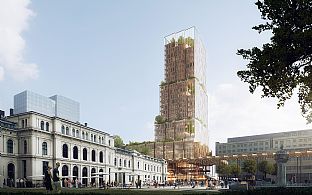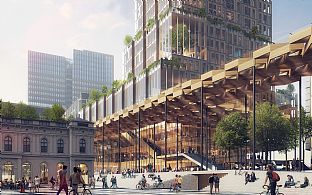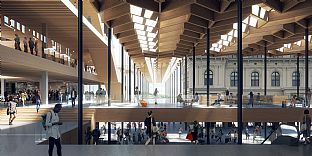Reiulf Ramstad Arkitekter in collaboration with C.F Møller Architects wins an international competition for a new high-rise building and station in the centre of Oslo
The restricted planning and design competition for the design of "Fjordporten Oslo S" was launched under the auspices of Bane NOR Eiendom (BNE). A total of 24 teams applied to participate in the competition, of which four were selected to participate.
The winning team behind the "Nordic Light" project consists of Reiulf Ramstad Arkitekter AS in collaboration with C.F. Møller Architects, Bollinger + Grohmann Ingenieure, Baugrundinstitut Franke-Meißner und Partner, GMBH and Transsolar Climate Engineering.
Spatial and location qualities
A unanimous jury chose Nordic Light as the winner, and the jury’s motivation states:
"The project's proposed integration with the station areas and the design’s holistic approach will contribute to further developing Oslo S as the country's largest public transport hub, and will give travellers wonderful new spatial qualities to appreciate. The project presents good solutions for the cohesive design of the adjoining urban spaces. This approach gives good potential to safeguard and highlight the listed Østbanen station, and will give it a central role as part of the station's visual identity. The project is credible and feasible and displays an understanding of the complexity that this assignment invites ...."
Subtle interaction with the surroundings
The building consists of a tower with a base. The tower mainly houses offices, while the base contains service functions for travellers. The building volume teams up with Østbanehallen’s towering "cathedral space", and tapers downwards with inspiration from Oslo's landscape and buildings. By combining the use of timber with modern materials such as structural concrete and high-tech glass, the building's materiality is a subtle reference to the time when the city was built from wood. Together, the various materials form an organic façade that stands as a landmark of the city.
Nordic light with plenty of daylight
The tower is bathed in daylight. The workspaces have shared infrastructure, break rooms and informal meeting places to facilitate a flexible, mobile working life. "Green lungs" in the form of vertical atriums across multiple levels and terraces with vegetation provide ample contact with the city and its landscape. Since the multi-storey building is to contribute to the city’s life, the tower is planned to have public areas, as a spectacular vantage point that is accessible to everyone.
The design of the base supports easy wayfinding, with a building structure that is legible and facilitates smooth transfer between the various means of transport. A wooden pergola of lightweight mesh structures defines the central railway station's new main entrance, while spacious sitting steps connect the area to Østbanehallen’s food market.
The project sets ambitious sustainability goals, with high BREEAM classification (excellent), and focus on LCC, LCA and flexible solutions for the use of the building, as well as on the construction process and the future operations.
Background to the competition:
In June 2017, Bane NOR Eiendom (BNE) announced a restricted planning and design competition for the design of "Fjordporten Oslo S".
During the next few years, Bane NOR will develop Oslo S, in order to streamline and improve the public transport hub, facilitate property development and effective land use to support the hub, the development of travel service and commercial offers, and the development of Oslo S to a high standard of architectural quality. The first stage of this is the "Fjordporten" station and multi-storey building project.
Fjordporten will play a prominent role in the cityscape with its central location, volume and elevation, and its role in the public transport hub. Bane NOR Eiendom has high ambitions for this project and with the restricted planning and design competition for Fjordporten wishes to find a new structural expression for the multi-storey building which better interacts with the surroundings and provides a good basis for implementation, while ensuring a high standard of architectural quality.
Jury
The submitted designs were assessed by a jury which comprised the following:
Ellen Haug, Civil Architect, MNAL, Project Head, BNE
Tor Saghaug, Civil Engineer, Project Director, BNE
Rune Breivik, Cand.agric. Project Head, BNE
Jostein Berger Meisdalen Cand.agric., Senior Engineer, Bane NOR Infrastructure
Knut Øivind Ruud Johansen. Director of stations, BNE
Geir Haaversen, Civil Architect, MNAL, A lab
Gudmund Stokke, Civil Architect, MNAL, Nordic
Andreas Fadum Haugstad, Civil Architect, MNAL, National Association of Norwegian Architects, was secretary to the jury.
Competition team
24 international teams applied to participate in the competition. The following four teams were selected:
- Reiulf Ramstad Arkitekter, C. F Møller, Bollinger + Grohmann Ingenieure,
Baugrundinstitut Franke-Meißner und Partner, GMBH,
Transsolar Climate Engineering
- BIG Bjarke Ingels group, Element arkitekter, Midtconsult, ÅF Engineering
- Ingenhoven Architects (D), Common Ground (Oslo/Berlin), Atelier Loidl Landschaftsarchitecten, Werner Sobek, CDM Smith Consult
- Sauerbruch Hutton (Berlin), Studio Oslo landskapsarkitekter, Bollinger & Grohmann Ingeniører (Oslo), Golder associates







